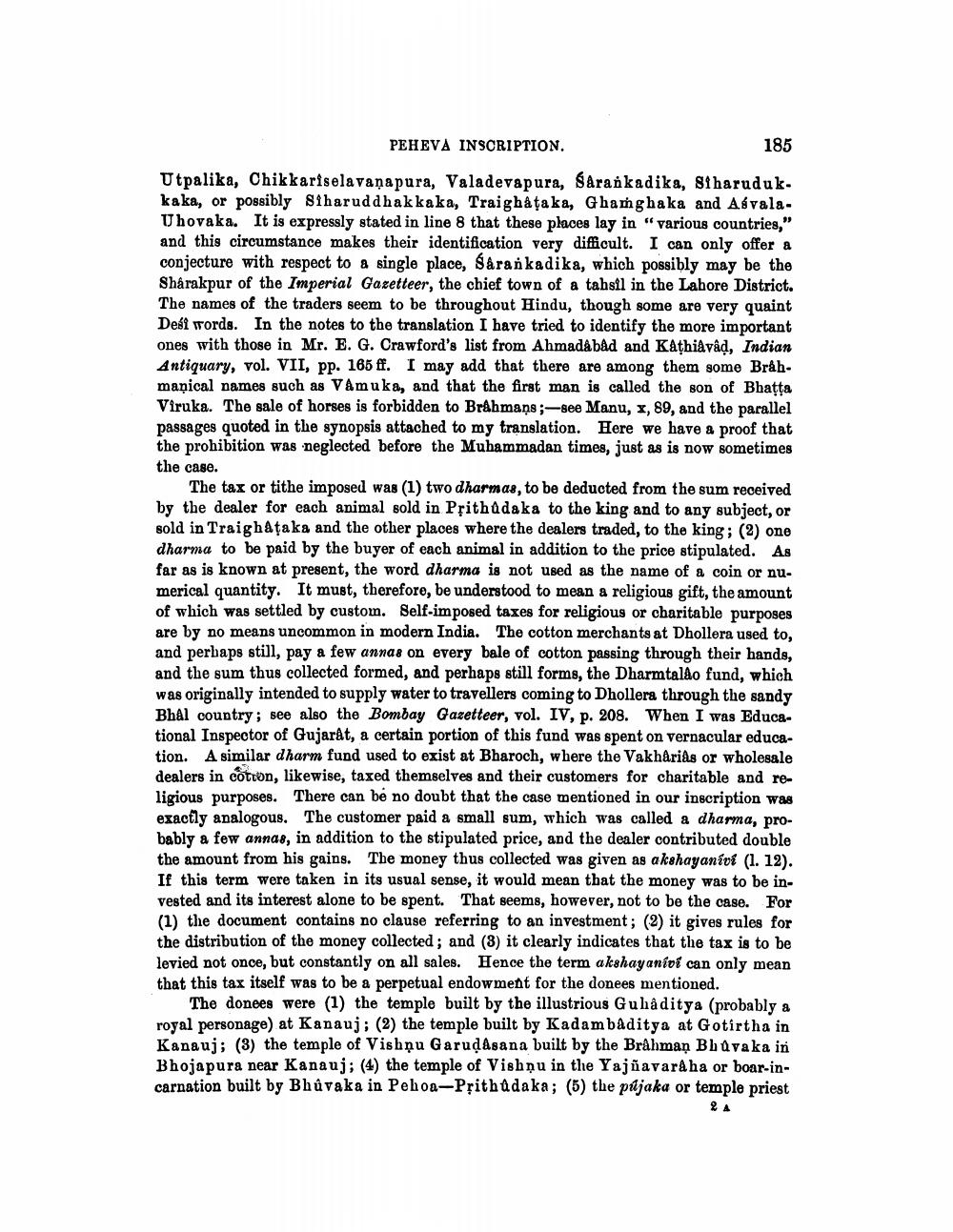________________
PEHEVA INSCRIPTION.
Utpalika, Chikkariselavanapura, Valadevapura, Sarankadiks, Stharudukkaka, or possibly 81haruddhakkaks, Traighataka, Ghamhghaka and AdvalaUhovaka. It is expressly stated in line 8 that these places lay in "various countries," and this circumstance makes their identification very difficult. I can only offer a conjecture with respect to a single place, Sarankadiks, which possibly may be the Sharakpur of the Imperial Gazetteer, the chief town of a tahsil in the Lahore District. The names of the traders seem to be throughout Hindu, though some are very quaint Desi words. In the notes to the translation I have tried to identify the more important ones with those in Mr. E. G. Crawford's list from Ahmadâbâd and Kathiâvâd, Indian Antiquary, vol. VII, pp. 165 ff. I may add that there are among them some Bråhmanical names such as Vamuka, and that the first man is called the son of Bhatta Viruka. The sale of horses is forbidden to Brahmans;-see Manu, x, 89, and the parallel passages quoted in the synopsis attached to my translation. Here we have a proof that the prohibition was neglected before the Muhammadan times, just as is now sometimes the case.
185
The tax or tithe imposed was (1) two dharmas, to be deducted from the sum received by the dealer for each animal sold in Prithadaka to the king and to any subject, or sold in Traighâtaka and the other places where the dealers traded, to the king; (2) one dharma to be paid by the buyer of each animal in addition to the price stipulated. As far as is known at present, the word dharma is not used as the name of a coin or numerical quantity. It must, therefore, be understood to mean a religious gift, the amount of which was settled by custom. Self-imposed taxes for religious or charitable purposes are by no means uncommon in modern India. The cotton merchants at Dhollera used to, and perhaps still, pay a few annas on every bale of cotton passing through their hands, and the sum thus collected formed, and perhaps still forms, the Dharmtalão fund, which was originally intended to supply water to travellers coming to Dhollera through the sandy Bhal country; see also the Bombay Gazetteer, vol. IV, p. 208. When I was Educational Inspector of Gujarat, a certain portion of this fund was spent on vernacular education. A similar dharm fund used to exist at Bharoch, where the Vakhâriâs or wholesale dealers in cotton, likewise, taxed themselves and their customers for charitable and religious purposes. There can be no doubt that the case mentioned in our inscription was exactly analogous. The customer paid a small sum, which was called a dharma, probably a few annas, in addition to the stipulated price, and the dealer contributed double the amount from his gains. The money thus collected was given as akshayaniví (1. 12). If this term were taken in its usual sense, it would mean that the money was to be invested and its interest alone to be spent. That seems, however, not to be the case. For (1) the document contains no clause referring to an investment; (2) it gives rules for the distribution of the money collected; and (3) it clearly indicates that the tax is to be levied not once, but constantly on all sales. Hence the term akshayanivi can only mean that this tax itself was to be a perpetual endowment for the donees mentioned.
The donees were (1) the temple built by the illustrious Guhâditya (probably a royal personage) at Kanauj; (2) the temple built by Kadambaditya at Gotirtha in Kanauj; (3) the temple of Vishnu Garuḍâsana built by the Brahman Bhavaka in Bhojapura near Kanauj; (4) the temple of Vishnu in the Yajnavaraha or boar-incarnation built by Bhûvaka in Pehoa-Prithûdaka; (5) the pújaka or temple priest
2 A




